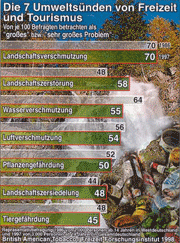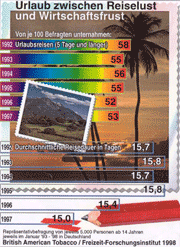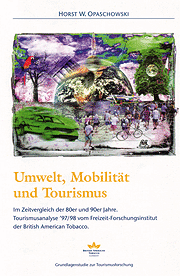Environment, mobility and tourism
8. Nationwide German Tourism Analysis
Travel year 1997: Unbridled wanderlust, but decreasing trip duration
Germans were eager to travel again. Despite rising unemployment and declining real incomes, their desire to travel increased last year: "Just get away!" said 53 percent of the population, who took a vacation of at least five days in 1997 (compared to only 52 percent the previous year). Nevertheless, the economic situation showed the first signs of a slowdown. While Germans' desire to travel remained relatively stable, their average trip duration decreased – from 15.8 days in 1995 to 15.4 days in 1996 and then to 15.0 days last year. This is according to the eighth nationwide tourism analysis conducted by the Leisure Research Institute of British American Tobacco, in which 5,000 German citizens aged 14 and over were surveyed about their vacation behavior in 1997 and their travel plans for 1998.
The desire to travel remains undiminished – yet the length of trips is decreasing: "With this balancing act, many Germans are preserving their most popular form of happiness even through difficult economic times," says institute director Prof. Dr. Horst W. Opaschowski. "Better to travel for a shorter time than not at all. A defiant reaction that is more psychologically than economically motivated." The principle of budget travel rather than foregoing travel altogether is currently particularly prevalent among the population of eastern Germany. Their average trip duration of 12.7 days in 1997 was significantly lower than the western German standard (15.6 days). This newfound freedom to travel has become an indispensable part of their quality of life.
This also explains the apparent contradiction of why more West Germans than East Germans stay home for their holidays. While 41 percent of West Germans don't travel, the figure for East Germans is only 38 percent: because East Germans are more willing to take shorter trips and have more modest comfort requirements, their travel frequency is also somewhat higher.
The emerging tourism trend of "cost-cutting measures reducing travel duration" means that the best weeks of the year are increasingly becoming the best days of the year. Only a minority can afford the classic three-week trip: 19 percent of all holidaymakers, or just about one-tenth (10.3 %) of the total population.
Domestic travel destinations 1997: Germans rediscover the Baltic Sea
""Domestic holiday destinations hardly stand a chance against the dream of eternal sunshine in southern countries," says Professor Opaschowski. Last year, for every two domestic tourists (40 %), there were three international tourists (60 %). In this respect, little has changed in recent years. Consistency is key: international destinations cannot simply be replaced by domestic ones.
The most popular domestic travel destinations remain Bavaria (7), the North Sea (7), and the Baltic Sea (8). Compared to the previous year, it is noticeable that Germans (especially those from West Germany) are rediscovering the Baltic Sea. The Baltic coasts of Schleswig-Holstein and Mecklenburg-Western Pomerania overtook the Bavarian holiday regions last year. Only minor differences can now be observed in the preferences of West and East German vacationers. West Germans particularly enjoy traveling to the North Sea and Baltic Sea. East Germans find the holiday regions in Eastern Bavaria, Upper Bavaria, and the Allgäu more attractive. In contrast, the holiday regions in the former East Germany are becoming less appealing to them. In 1990, every second East German (52) spent their vacation there; by 1992, this figure had dropped to only one in five (20). And last year, only 13 percent of East German tourists stayed there – a new low.
Foreign travel destinations 1997: Spain unchallenged at the top
Last year, the sun shone almost exclusively in Spain. Every sixth or seventh vacationer (15%) chose Spain as their destination. A year earlier, it had been only eleven percent. The increase of over one million additional travelers leaves Spain firmly at the top. East Germans, in particular (1996: 5% – 1997: 11%), are increasingly catching up to the favorite destination of West Germans (1996: 12% – 1997: 16%). Institute Director Opaschowski: "For one in six West Germans, it's now: 'Spain, Mallorca – and goodbye!' The growing appeal of Spanish destinations is increasingly putting pressure on other holiday regions.""
Austria is suffering the most from the Spain trend. Like no other holiday destination, Austria has been experiencing an unprecedented decline for several years: compared to 1990, the number of German tourists visiting Austria has halved (1990: 10 – 1997: 5). For the past four years, the number of German tourists has been steadily decreasing (1994: 8 – 1995: 7 – 1996: 6 – 1997: 5). Italy, as in the previous year (1996: 8 – 1997: 8), remains firmly in second place among the most popular destinations for German travelers abroad.
The German yearning for warmth, distant lands, and wide open spaces is clearly limited by financial constraints. Neither the USA nor the Caribbean (including Cuba and the Dominican Republic) has been able to increase its share of travel. Trips to the USA are stagnating or slightly declining (1994: 3,100,300; 1995 to 1997: 2,100,300 each year). It is more likely that Caribbean destinations will be in greater demand in the near future (1994: 1,100,300; 1995 to 1997: 2,100,300 each year).
Travel intentions 1998: Uncertainty among the population
Declining real incomes, rising social security contributions, and looming price increases are leaving many Germans with less and less room for vacation spending. Many suitcases will remain unpacked in 1998. The German public's desire to travel is taking a noticeable hit. Germans haven't been this uncertain in a long time. Almost one in four Germans (23) absolutely does not want to travel, which, compared to previous years (1996: 21; 1997: 22), suggests a steady increase. The growing uncertainty among Germans (1996: 27; 1997: 28; 1998: 29) will be just as much of a concern for the travel industry, as they are still unsure whether they want to or can travel.
Certainly no reason for a crisis, but the boom times in tourism are over for now. Only slightly less than half of all Germans (48) plan to travel this year or already have their bags packed – a noticeable decline compared to previous years (1996: 52 – 1997: 50). Germans are by no means tired of traveling. Rather, they are struggling with the problem that their desire to travel sometimes exceeds their travel budget. Will the slump follow the 1997 peak in the coming travel season?
Some signs indicate that while Germans will remain world-class travelers on the road to the year 2000, they may no longer be world champions in spending money on foreign trips. This is because in 1998, Germans are cutting back – even on vacations! The motto is clear: shorter trips at lower prices.
Travel destinations 1998: Plenty of sun for little money
A representative survey conducted by the Leisure Research Institute of British American Tobacco regarding planned travel destinations for 1998 reveals that less than one in four Germans with firm travel plans (23%) intend to vacation within Germany. More than three-quarters, however, are determined to travel abroad. As in previous years, Spain remains the favorite destination for Germans. One in seven Germans planning a trip this year has chosen this destination (14%). Austria (8%) and Italy (8%) follow on the wish list. If this wish is fulfilled, Austria could gain further ground. However, the intense competition with other holiday destinations continues – particularly between Greece (6%), Turkey (5%), Scandinavia, and France (both 4%).
Comparing travel intentions with the previous year, it is noticeable that Tunisia and Morocco are once again gaining popularity (1997: 11,300 – 1998: 31,300). Sunshine is guaranteed there, and apparently, so is affordability. The necessary contrast to everyday life is also provided by the combination of southern and exotic experiences. Desired destinations such as the USA (1997: 31,300 – 1998: 21,300) or the Caribbean (1997: 31,300 – 1998: 21,300) will feel the competition from more affordable sunny destinations.
Because for many, the desire for travel is simply unaffordable. Price-conscious vacationers will ensure that the level of long-distance tourism from last year is only barely reached, and perhaps even surpassed. A boom in long-distance travel is not to be expected.
When it comes to planned trips abroad in 1998, West and East Germans have very different priorities. West Germans clearly favor trips to Spain and Italy more than East Germans. For East Germans, on the other hand, trips to Hungary, Tunisia, and Morocco are more appealing. Budget and habits determine the travel destinations for the coming season.
Landscape destruction and urban sprawl: The environmental sins of tourism today
As the main focus of its current tourism analysis, the Leisure Research Institute of British American Tobacco revisits one of the central questions from the 1980s: the environmental awareness and behavior of vacationers. What has changed since then? First, a clear shift in the environmental awareness of German citizens is emerging. The perception of air and water is losing importance. At the same time, the fear of tourism-related landscape destruction, for example by ski slopes and lifts, which leave lasting damage, has increased significantly in recent years (1986: 48 – 1997: 58). Furthermore, the perceived environmental impact increases with the level of education (primary school graduates: 58 – university graduates: 67). "An expansion of vacation tourism is always associated with landscape destruction," says Professor Opaschowski. "The conversion of nature into publicly accessible holiday areas inevitably encroaches on untouched areas, open landscapes become overdeveloped, and free access to lake shores and coastlines is often blocked.""
Another burden on the landscape is seen in the para-hotel sector, i.e., second homes and their commercialization through private rentals. For years, there has been an explosive increase in non-hotel-style accommodation: weekend homes and vacation apartments are "sprawling" across the landscape. Rural sprawl is considered a major or very major environmental problem by every second German citizen (1986: 44% – 1997: 48%). The average land consumption for leisure and vacation travel is high. Approximately 30 square meters of land need to be developed for a hotel guest, 50 square meters for a camper, and over 160 square meters for a second-home owner.
Among the other environmental sins of tourism, the vast majority of the population (70% %) still considers landscape pollution caused by day-trippers and vacationers to be a major problem. This assessment has remained unchanged over the last ten years (also 70% % in 1986). What makes nature such a problematic scene of the crime, according to the population, is the visibility of the offense, the lasting eyesore, the sheer quantity, and the persistence of the problem (e.g., with plastic bags).
Many environmentally conscious people, few who change their behavior: A comparison of the 80s and 90s
There are still many environmentally conscious people, but few who actually change their behavior. The new survey shows that, just as ten years ago, Germans today waver between resistance and retreating to fundamental principles. There is a strong tendency to seek solutions to environmental problems, firstly, in fundamental principles, and secondly, in others. There is also a great fear of restrictions on personal spontaneity and freedom – the fear of no longer being allowed to stray from the path. When things get serious, i.e., personal, most Germans still react with avoidance tendencies.
Initially, the behaviors that find the greatest acceptance are those that are relatively simple and convenient, meaning they can be practiced without much effort. 76 percent always take their trash home with them when they go on outings (7 percentage points less than in 1984). Every second person (51 percent) actively seeks information about environmental problems, which represents a decrease of ten percentage points compared to 1984. Perhaps the level of information is higher today, or perhaps the psychological saturation point has been reached: people don't want to be constantly confronted with environmental problems.
Furthermore, a clear, though not revolutionary, change in behavior can be observed: Two-thirds (66) of tourists no longer hike off-trail. In 1984, this figure was only 58. And every second tourist (56 – 1984: 43) no longer seeks out remote natural and scenic areas. Professor Opaschowski: "Overall, the population's willingness to make ecological sacrifices remains relatively low, because vacation activities always also mean personal quality of life – here and now, not just tomorrow." Alongside environmental concerns, Germans subjectively prioritize the quality of their vacation. In their eyes, the quality of their own vacation is almost as worthy of preservation and protection as the environment.
""Not I, the state should do something!""
From building bans to driving bans
Ninety-one percent of the population support widespread education and information about the environmental impact of leisure tourism. A further 89 percent call for targeted learning and teaching programs in schools. These high approval ratings are understandable, as they require neither sacrifice nor restraint from the individual. More information can't hurt – and it doesn't cause any harm either.
An unusual environmental and transport policy measure has now gained almost majority support: the introduction of a flexible weekend, where employees can voluntarily choose between a Friday/Saturday, Saturday/Sunday, or Sunday/Monday off, to reduce environmental impact (1984: 39 % – 1997: 50 %). Implementing such a measure would benefit not only the environment, but also the restaurant and hotel industry, leisure and recreational facilities, and ultimately, weekend vacationers themselves.
Driven by a certain deference to authority, some demand draconian sanctions from the state. These include:
- Driving and parking bans in local recreation areas, leisure and nature reserves (1984: 74 % – 1997: 75 %);
- Settlement and building bans in open countryside (1984: 67 % – 1997: 69 %);
- Speed limit 30 km/h in the immediate vicinity of recreational areas, leisure and nature reserves (1984: 60 % – 1997: 73 %);
- Prohibition against being in the forest and nature reserves outside of public paths (1984: 56 % – 1997: 72 %).
Most Germans feel more affected and suffering in the tourism-related environmental debate than they do responsible. They tend to rely on government regulations and bans to solve the problems, almost waiting for a push from above. The call for "law and order"—from building bans to driving bans to hiking bans—has increased significantly since the 1980s.
Environmental concerns are far from being outdated for vacationers. Quite the opposite: the environmental debate has actually made vacationers more sensitive to these issues. They now expect more – from politicians and tour operators, of course, not from themselves. Furthermore, a comparison of the 1980s and 1990s makes it clear: environmental awareness is translated into practical vacation behavior by taking the path of least resistance. Environmental protection must not be inconvenient or even noticeable during a vacation.
""For, not against, the interests of the local population""
New approaches to a sustainable tourism policy
A tourist in a luxury hotel uses four to five times more water than a local resident (130 liters). From this perspective, the excessive consumption of water and energy resources fundamentally affects the livelihoods of the local population. To ensure that the basic needs of the local population are not jeopardized, one in two German citizens (53% of respondents) recommends making energy and water conservation mandatory in tourist areas. Furthermore, no new holiday resorts should be built against the interests of the local population in the future (65% of respondents).
Tourism criticism is currently undergoing a qualitative shift: From the predominantly "green" critique of tourism and its consequences for nature and landscape, a tourism ethic is developing that is both concrete and practically oriented, focusing more on those being visited than on the travelers themselves. Tourism is no longer seen solely as a natural and environmental disaster, nor are tourists viewed only as strangers or enemies. The vast majority of the population (57 %) believes that the most effective measure to prevent the negative consequences of mass tourism is to consider the interests of the local population.
Future tourism planning must be much more about prioritizing the quality of life for local residents. Locals should be able to decide for themselves how much economic, social, and cultural prosperity they want in their region. Because they will feel the consequences – both positive and negative – for a lifetime, while the tourist caravan simply moves on.
See also directory of all publications






